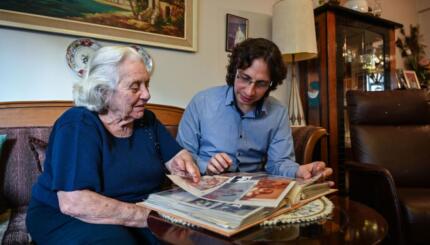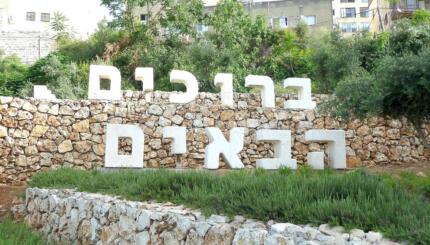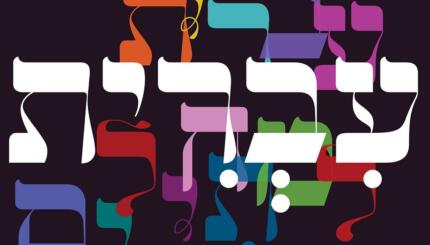The transition from Medieval to Modern or Israeli Hebrew came about slowly, over several decades. According to some experts, a new phase of the language had already begun in the 16th century. Among its earliest manifestations were A. dei Rossi’s Me’or Einayim (1574), the first Hebrew play by J. Sommo (1527‑92), and the first Yiddish‑Hebrew dictionary by Elijah Levita (1468‑1549). Hebrew continued to be used in writing, and attempts were made to adapt it to modern needs.
The Haskalah (Jewish Enlightenment)
The 18th century saw the first examples of Hebrew newspapers, in connection with which I. Lampronti (1679‑1756) at Ferrara and, from 1750, M. Mendelssohn at Dessau were pioneers. From 1784 until 1829 the quarterly review Ha‑Me’assef appeared fairly regularly. Edited by the “Society of Friends of the Hebrew Language,” it received contributions from important figures of the Haskalah [the Jewish Enlightenment]. The first regular weekly, Ha‑Maggid, began publication in Russia in 1856.
In the second half of the 18th century, the Haskalah made a significant impact on the language. The new “illuminati” or maskilim viewed Rabbinic Hebrew with disdain, believing it to be full of Aramaisms [i.e. Aramaic derivatives] and replete with grammatical errors, and they lamented the sorry state of Hebrew in the Diaspora. According to them, the blame lay with the paytanim [medieval liturgical poets], the influence of Arabic in medieval philosophy, the use of the “corrupt” Yiddish language, and with the inadequacies of Hebrew itself in comparison with other languages.
The most important representatives of this cultural movement tried to restore Hebrew as a living language. Not only did they attempt to purify the language and to promote correct usage, but they also increased its powers of expression, and showed little aversion to calquing modern terms from German and other Western languages.

Help us keep Jewish knowledge accessible to millions of people around the world.
Your donation to My Jewish Learning fuels endless journeys of Jewish discovery. With your help, My Jewish Learning can continue to provide nonstop opportunities for learning, connection and growth.
Although certain figures regarded Rabbinic Hebrew as a legitimate component of the new language, the majority settled on a pure form of Biblical Hebrew for poetry and on an Andalusian style of prose, similar to that used by the Ibn Tibbons [a family of Jewish translators who flourished in the 12th and 13th centuries].
Poets like A.D. Lebensohn and J.L. Gordon, writers like M. Mendelssohn, N.H. Wessely, I. Satanow, and J.L. Ben‑Ze’ev, dramatists like D. Zamoscz (who wrote the first modern play, in 1851), novelists like, A. Mapu (who, in 1853, composed the first work to use this new style), and even translators of Yiddish like S.J. Abramowitsch (Mendele Mokher Seforim), at the close of the 19th century, all helped in important ways to lay the foundations of Modern Hebrew.
Although some 19th‑century writers tried to use a fundamentally biblical form of language, they often introduced structures that were alien to its spirit and frequently made grammatical errors, incorrectly employing the article with nouns in the construct state, treating intransitive verbs as transitives, confusing particles, and so on.
Also, they frequently had recourse to turgid paraphrase in a desperate attempt not to stray from the limited vocabulary of the Bible for expressing contemporary referents, thus endowing many biblical expressions with new content. A. Mapu, whom we have already mentioned, emphasized the inadequacy of Biblical Hebrew for the demands of literature and advocated the use of post‑biblical sources.
This tendency is clearly seen in the work of Mendele Mokher Seforim (1835‑1917), whom many regard as the real creator of Modern Hebrew. Jewish culture underwent a marked change at the end of the 19th century, with the abandonment of the ideal of assimilation and its replacement by the nationalist and Zionist program of the Hibbat Zion.
Mendele, who wrote in both Yiddish and Hebrew, accepted into his language the most varied elements not only from Biblical Hebrew but also from all the later stages of the language, as well as from Yiddish. J.H. Alkalai, A.J. Schlesinger, Y.M. Pines, and others also made successful contributions to the task of ensuring that Hebrew would once more possess the character of a spoken language.
Hebrew in Palestine (Pre-State Israel)

A new era opened with the publication in 1879 of Eliezer Ben‑Yehuda‘s article entitled “A burning question.” The use of Hebrew as a spoken language was to be for Ben‑Yehuda one of the most important aspects of the new plan for settlement in Palestine.
From 1881, Ben‑Yehuda lived in Jerusalem, and starting with his own family, forged ahead with his objective of changing Hebrew into a language suitable for daily use. With enthusiastic backing from such supporters of the nationalist cause as Y.M. Pines and D. Yellin, he struggled to give new life to the language. One of his greatest endeavors was to develop an appropriate vocabulary, in which Ben‑Yehuda incorporated material from ancient and medieval literature and created new words eventually to be included in his monumental Thesaurus (continued after Ben-Yehuda’s death by M.H. Segal and N.H. Tur‑Sinai).
Although the Jews who were already established in Palestine had previously used Hebrew as a lingua franca [a common language spoken by people who have different primary languages], it was not employed more generally, and the various immigrant communities continued to speak their native languages. Among the factors that helped turn Ben‑Yehuda’s dream into reality were the lack of a national language in the region, a desire on the part of successive waves of immigrants from central and eastern Europe to renew Jewish culture, and memories of the centuries of ancient grandeur that the Jews had once experienced in the very place they now lived.
Many other personalities played a part in this undertaking, which at the beginning appeared little less than impossible. Among them were important groups of teachers who adopted the cause of teaching Hebrew via Hebrew.
During this first stage of the revival, which lasted up to 1918, consideration was given to a number of problems in phonology (adaptation of Hebrew to the pronunciation of foreign names, resulting in the introduction of some graphemes that are followed by an apostrophe), orthography (adoption of scriptio defectiva), and morphology and syntax (no deliberate major changes).
However, the process did not follow just one path–at the end of the 19th century, for example, I. Epstein and other leading teachers cultivated a separate pronunciation in Galilee that continued to gain ground until 1920 before eventually disappearing completely.
But the most pressing issue was the creation of new words, the basic task of Ben‑Yehuda and the Va’ad ha‑Lashon [Language Council], which began to operate in 1890. In the introduction to Ben‑Yehuda’s Thesaurus, the methods employed for adapting the language to everyday needs are explained.
These include a return to the scientific and technical Hebrew vocabulary of the Tibbonid translations and the introduction of Arabic loanwords on the basis of semantic proximity to Hebrew, with their forms adapted to Hebrew patterns. From the Mishnah, Talmud and midrashim, Ben‑Yehuda adopted any potentially useful Hebrew and Aramaic expressions, and even Greek and Latin loanwords.
Aramaic morphological patterns and suffixes were employed, and precise senses established for infrequent biblical words, especially hapax legomena [a word that appears only once in the texts of a given language], the meanings of which are not evident from context. Roots attested in Biblical Hebrew were exploited to derive additional vocabulary according to traditional morphological patterns. The end result of this was an immense and thoroughgoing enhancement of the expressive potential of the language.
Reprinted from A History of the Hebrew Language with the permission of Cambridge University Press.
Want to learn Hebrew one day at a time? Click here to sign up for our Hebrew Word of the Day email.



